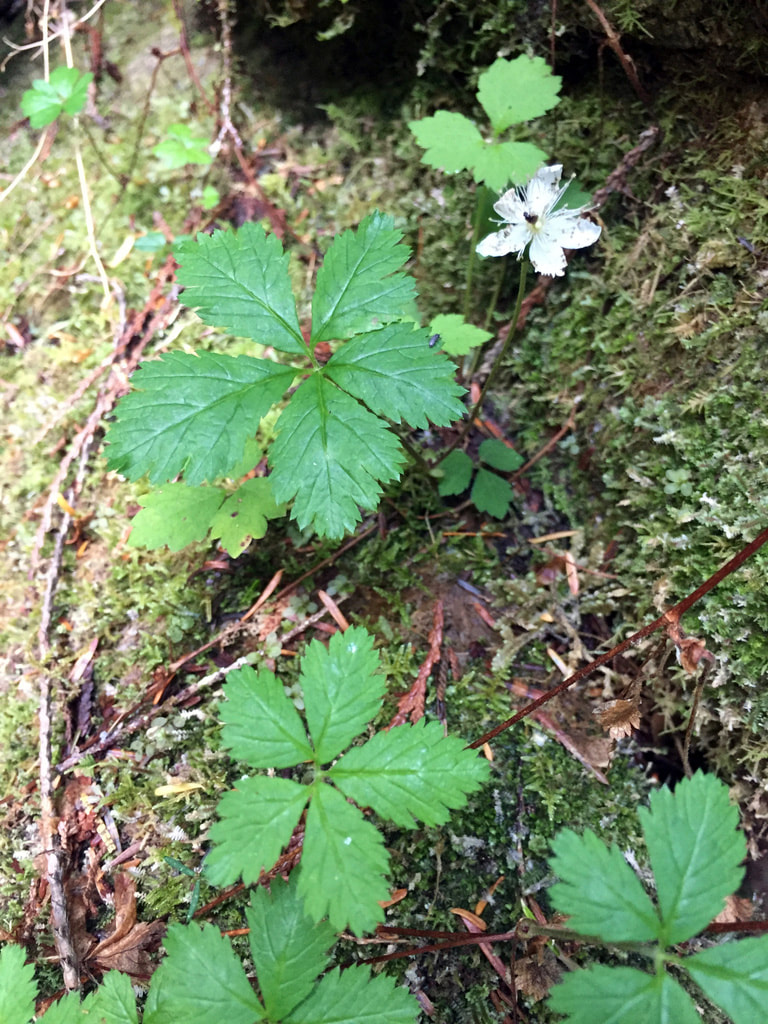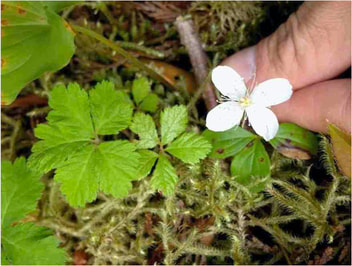Five-leaved bramble, creeping raspberry, strawberryleaf raspberry • Rubus pedatus
{Bramble = derived from Old English word meaning 'wiry or thorny shrub;' pedatus = foot, possibly a reference to the paw-print like shape of the lobed leaves}
Photos by John Reynolds (left), Kelly Fretwell (top right), and David Norwell (bottom right).
Identification
Five-leaved bramble is a low-lying, prickle-less, creeping raspberry species. Its common name is helpful, though somewhat misleading, for identification purposes: rather than each plant bearing five leaves, each leaf bears five leaflets. These leaftlets are oval-shaped and coarsely toothed. The petals of the small white flowers are widely spread or bent backwards, and occur singly on thin stalks. The fruits are raspberries take the form 1-6 small red spheres, or "drupelets," clustered in a raspberry-like formation.
Habitat & Range
Five-leaved bramble grows in moist mossy forests, glades, meadows, bog forests, and along streambanks, from low to subalpine elevations. It is a common species throughout BC, and is found across much of western North America. Its coastal range stretches from Alaska to Oregon.
Similar Species
Cloudberry (Rubus chamaemorus) leaves are shallowly five-lobed and the ripe berries are yellow and more raspberry-like.
Human Uses
Five-leaved bramble berries are edible and tasty - however they are not a staple traditional food for coastal First Nations because of their small size and softness.
iNaturalist
https://www.inaturalist.org/taxa/130220-Rubus-pedatus
Five-leaved bramble is a low-lying, prickle-less, creeping raspberry species. Its common name is helpful, though somewhat misleading, for identification purposes: rather than each plant bearing five leaves, each leaf bears five leaflets. These leaftlets are oval-shaped and coarsely toothed. The petals of the small white flowers are widely spread or bent backwards, and occur singly on thin stalks. The fruits are raspberries take the form 1-6 small red spheres, or "drupelets," clustered in a raspberry-like formation.
Habitat & Range
Five-leaved bramble grows in moist mossy forests, glades, meadows, bog forests, and along streambanks, from low to subalpine elevations. It is a common species throughout BC, and is found across much of western North America. Its coastal range stretches from Alaska to Oregon.
Similar Species
Cloudberry (Rubus chamaemorus) leaves are shallowly five-lobed and the ripe berries are yellow and more raspberry-like.
Human Uses
Five-leaved bramble berries are edible and tasty - however they are not a staple traditional food for coastal First Nations because of their small size and softness.
iNaturalist
https://www.inaturalist.org/taxa/130220-Rubus-pedatus
References
Pojar, J. and MacKinnon, A. (1994). Plants of Coastal British Columbia. Vancouver, BC: Lone Pine Publishing. P. 79.
Rubus pedatus Sm. In Klinkenberg, Brian. (Ed.). E-Flora BC: Electronic Atlas of the Plants of British Columbia. Lab for Advanced Spatial Analysis, Department of Geography, University of British Columbia, Vancouver. Accessed 31/10/2014.
Authors and editors of page
Kelly Fretwell and Brian Starzomski (2014)
Pojar, J. and MacKinnon, A. (1994). Plants of Coastal British Columbia. Vancouver, BC: Lone Pine Publishing. P. 79.
Rubus pedatus Sm. In Klinkenberg, Brian. (Ed.). E-Flora BC: Electronic Atlas of the Plants of British Columbia. Lab for Advanced Spatial Analysis, Department of Geography, University of British Columbia, Vancouver. Accessed 31/10/2014.
Authors and editors of page
Kelly Fretwell and Brian Starzomski (2014)







